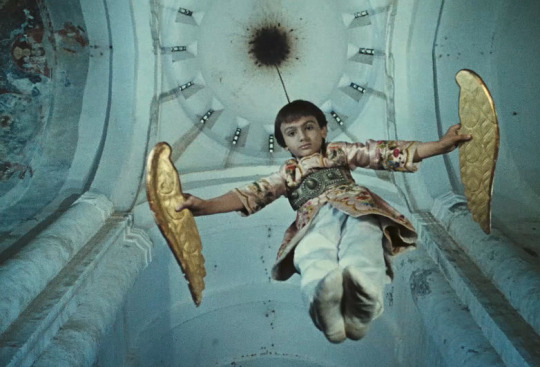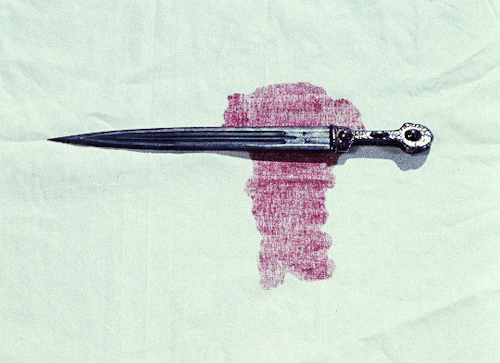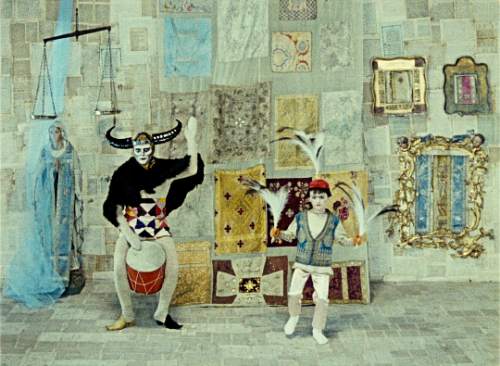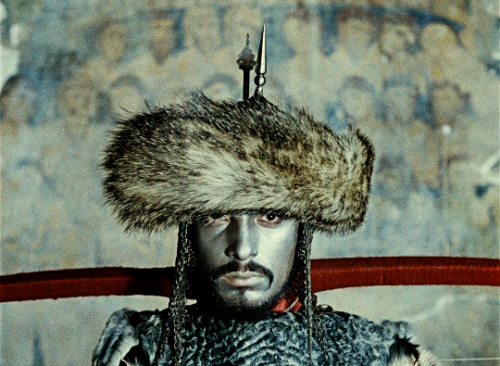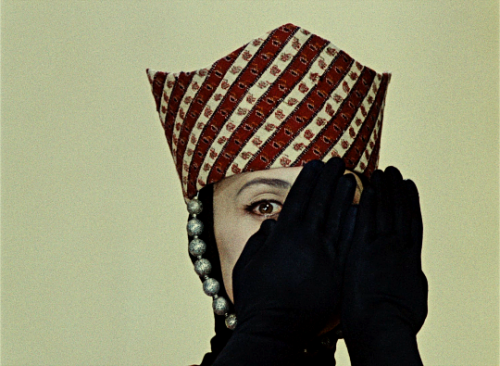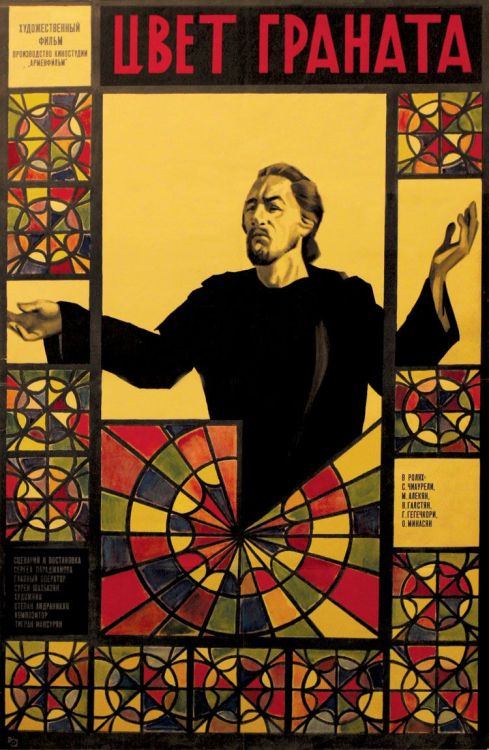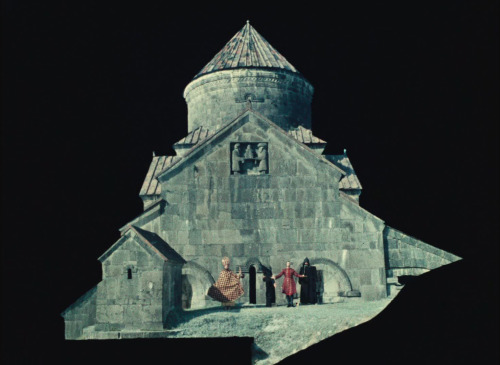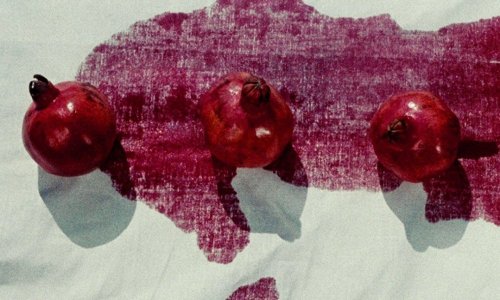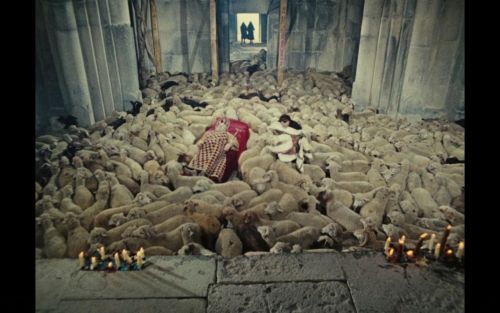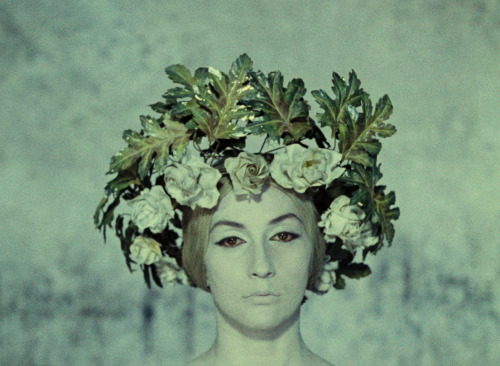#the color of pomegranates
The Color of the Pomegranates, 1969
Directed by Sergei Parajanov
sound on please

Icon commission of Sofiko Chiaureli in The Colour of Pomegranate
The Color of Pomegranates (1969)
Directed by Sergei Parajanov
Doomsy’s Rating: 92/100 (on my Great Films list!)
Serving as an amazing double feature with Valerie and Her Week of Wonders, Sergei Parajanov’s untouchable art-house masterwork The Color of Pomegranates is a one-of-a-kind experience that is an absolute visual feast from start to finish. The film is based on the life of Armenian poet Sayat-Nova, and is told through in a series of tableau set-pieces of rich symbolism and psychedelic mise-en-scene manipulation. A clear influence on several prominent pieces of modern media (namely the music videos for R.E.M.’s “Losing My Religion” and Lady Gaga’s “911″), this is a spoonfeeding of the Armenian oral tradition and its glorious cultural history. Although heavily censored by the Soviet Union against the wishes of Parajanov, likely for its less-than-flattering subtext about the occupation of the Soviets, the film remains a transcendent and enchanting journey through a culture never seen before on film. The use of color, so exquisite in its breadth, is nearly kaleidoscopic and wholly unforgettable. There is a certain patience required for a film like this, as its not a film that is best served in narrative terms, but that should not deter anyone from such an enigmatic and beautiful work. If you like your films a little impenetrable and mysterious, this is a tone poem for the ages.
Watched on Criterion Channel.
Post link

The Color of Pomegranates (1969), Sergei Parajanov


The Color of Pomegranates (1969), Sergei Parajanov


The Color of Pomegranates (1969), Sergei Parajanov

(1969) Directed by Sergei Paradjanov
“In the temple of cinema there are images, light, and reality. Sergei Paradjanov was the master of that temple.” Jean Luc Godard
It makes for challenging viewing at times, but this astonishing and baffling picture is a deeply moving example of artistic determination and originality.
Now at its 50thanniversary, there is nothing else like it in all of cinema. Paradjanov’s work inevitably inspires viewers afterwards to share, in near ecstatic terms, what they witnessed.
Although the “story” ostensibly details the life of 18th-century Armenian national poet and troubadour Sayat Nova, there is no plot and no narrative. Except in a few instances, the camera does not move, and there is no dialogue. Events do not unfold chronologically. Using even the very loosest definition of “motion picture,” it is accurate to say that a screening of The Color of Pomegranatesdoes not constitute a night at the movies.
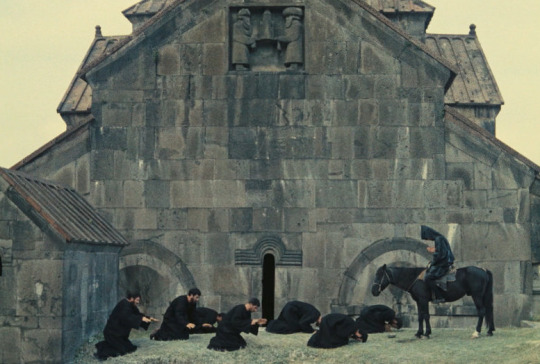
In many scenes, which are usually static tableau in which characters move in and out of frame, Paradjanov uses a motion picture camera to recreate religious icon paintings. It is impossible to determine which scenes depict the life of Christ and which deal with Sayat Nova, and so it may be Paradjanov’s intention to conflate the two. More puzzling than the icon tableau are those moments when truly beautiful men and women calmly and resolutely stare directly into the camera while conducting enigmatic rituals or making odd gestures.
The art direction and carefully choreographed action are lovely to behold (credit to designer Stepan Andranikyan and cinematographer Suren Shakhbazyan), but Paradjanov adds an overtly surreal element to these tableau. Objects levitate or disappear, apparel unfolds from bodies, and water flows out of walls. The score, consisting of horn blasts, lutes, lyres, and gorgeous choral pieces, has an ancient quality that lends a somber or sacred tone. A narrator reads Sayat Nova’s poetry, and although his words somehow manage to make the proceedings still more baffling, it is apparent that we are witnessing a deliberate, shamelessly personal blending of cinematic surrealism with Eastern-Orthodox Christian traditions. The result is transcendental.

That isn’t all that Paradjanov deftly blends. The sensual quality of some of his characters is subtle, but when cleverly juxtaposed with religious icons and scenarios, certain gestures evoke a mild eroticism that creates considerable tension. Paradjanov expresses yearning, despair, and ecstasy through this method, and it is easy to forget that these are mostly static images with no dialogue or plot. Combined with excerpts from Nova’s poems, many scenes recall the sensual, ecstatic, and transcendental works of the Sufi mystic poet Jalaluddin Rumi.
In such instances, Paradjanov is blending the sensual with the sacred, the spiritual with the mystical. He ultimately blends Armenian culture and Christian lore into a single, mystical vision. The vision may defy interpretation, but the images are nonetheless indelible. They are in the truest sense a mystical meditation: calm and rigorously organized, yet irrational and ultimately ecstatic.

There are links to this kind of cinematic artistry. Paradjanov happily admitted to an influence by Pasolini (certain scenes in Pomegranates recall The Gospel According to St. Matthew), and there is plenty of influence in evidence by Cocteau, Ray, and Dovzhenko here as well. In turn, Paradjanov influenced his contempories. His work gently hovers over Fellini’s Satyricon andCasanova. Some of the more experimental efforts by Derek Jarman recall a few of Paradjanov’s techniques, and Peter Greenaway’s Prospero’s Books looks in places like a direct homage to The Color of Pomegranates.
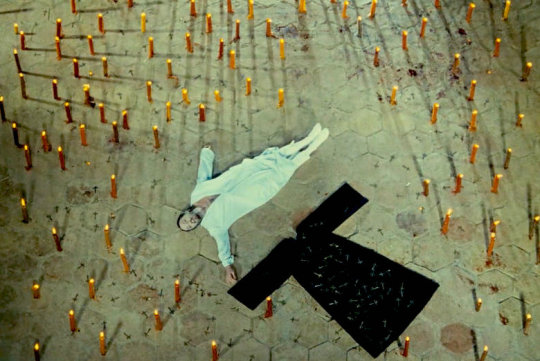
Still, in terms of style or effect there is no cinematic effort that comes before it and suggests such a thing, or any that may be placed after it as a next step. This amazing work seems to have simply landed here, which is true of many pure products of the imagination. For imagination, Paradjanov was never lacking, as his memorable comment on what it means to be a director suggests:
“It’s like a child’s adventure. You take the initiative among the other children, creating a mystery. You mould things into shape and create. You dress yourself as Charlie’s aunt or as Hans Christian Andersen’s heroes. Using feathers from a trunk you transform yourself into a rooster or a firebird. You torment people with your artistic delight, scaring mother and grandmother in the middle of the night. This is what directing is. You can’t learn it. You have to be born with it.”
